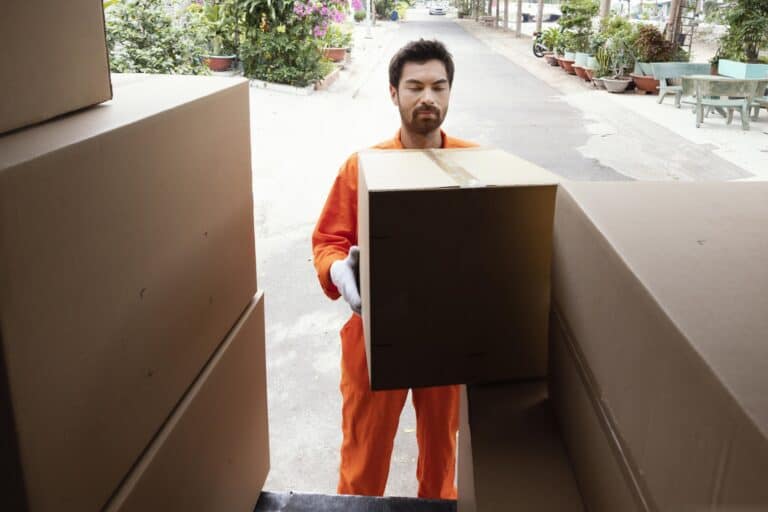Relocating brings its own set of challenges, and if you’re a pet owner, ensuring your companion’s safety during the move tops that list. Managing pet transportation when moving house doesn’t have to be stressful. From selecting the right carrier to comforting them in your new home, our direct, step-by-step guide is here to simplify the process for you and your pet.
Key Takeaways
- Start planning your pet’s move early, maintaining their routine for comfort, and consider professional pet movers for guidance and emergency preparation.
- Choose the right-sized carrier for your pet’s safety and comfort, and get them acclimatised to it and the travel vehicle well before the move.
- Upon arrival, create a dedicated, comfortable space with familiar items for your pet, and update their identification to ensure their safety in the new home.
Crafting a Pet-Friendly Moving Plan
Starting the moving process without a pet-friendly plan is like navigating a maze blindfolded. This is why it’s crucial to start preparations early to ensure a smooth house move with your pets in Hackney. The perfect strategy involves a sprinkle of foresight and a generous scoop of understanding your pet’s unique personality. Initiate the countdown at least 2-4 months ahead of moving day, and sketch out a timeline that includes your furry friend at every step. Keep those tails wagging with a consistent routine of meals, playtime, and cuddles, even amidst the packing chaos. Dogs, in particular, thrive on stability, so maintain their old routine to keep their stress levels at bay.
However, you might feel overwhelmed by the thought of pet passports, transportation regulations, and a myriad of other details. That’s where professional pet movers step in, offering their expertise to navigate the complex terrain of moving pets cross-country or even abroad. Professional pet movers:
- Guide you through the intricate process, ensuring compliance at every step and prioritising your pet’s comfort.
- Provide a safety net for unexpected twists and turns.
- Help you prepare for unforeseen pet emergencies by setting up a network of trusted neighbours or a pet ambulance service.
Professional pet movers are there to make your pet’s move as smooth as possible, ensuring a stress-free moving experience.
Selecting the Right Pet Carrier for Comfort and Safety
Imagine your pet’s carrier as their personal moving day sanctuary. It must be a snug haven that’s just right – not too big that they feel lost at sea, and not too small that they’re packed like a sardine. The choice of a sturdy carrier should be based on your pet’s weight to provide a safe and comfortable environment. Soft-sided carriers crafted from materials like canvas or nylon are the go-to for small to medium-sized pets, offering a cosy embrace for the journey. And for those pets that prefer a room with a view, mesh windows provide the essential peek into the world while ensuring a well-ventilated voyage.
The choice of a sturdy carrier should be based on your pet’s weight …
When it comes to our more exotic companions, from the hopping bunnies to the majestic llamas, special accommodations are a must. Some recommendations for travelling with pets include:
- Spacious, escape-proof cages for the chewers
- Trailers with ample room for larger animals
- Secure locks and padded straps or handles for safety
- Wearable carriers for petite passengers, keeping them close to your heart and providing a comforting hands-free experience.
Remember, safety is paramount when travelling with pets.
Pre-Move Acclimatisation: Familiarising Your Pet with Their Travel Space
The secret to a stress-free relocation lies in allowing your pet to adjust to the new changes at their own pace. Introduce the carrier as a new friend, not a foe, with a trail of treats leading inside and maybe even a favourite toy to make the meeting a pleasant one. Cats, the curious explorers they are, might take their sweet time investigating this new contraption. Leave the carrier door ajar and a cosy blanket within; it won’t be long before they’re napping in their new mobile abode.
Why limit the familiarisation to just the carrier? Extend it to the vehicle as well. Short, joyful jaunts will help associate your car or moving truck with positive experiences, easing the anxiety that comes with unfamiliar surroundings. As moving day inches closer, the sights and sounds of change will become the backdrop of your pet’s daily life, paving the way for a smoother transition to their new surroundings. The goal is to create a bubble of comfort, from a familiar scent to the soft hum of a well-ventilated car, all working in concert to make your pet feel secure even when their world is shifting.
On the Road: Ensuring Your Pet’s Well-Being During Transit
Relocating to a new home is a significant journey, and it’s your responsibility to ensure your pet’s well-being throughout the process. Here are some tips to help you:
- Secure their travel sanctuary within the vehicle, nestling in familiar toys and blankets alongside the essentials of food and water.
- Minimise turbulence in their tummy and mind by avoiding meals before departure.
- Keep the atmosphere as cool and calm as a cucumber.
- Scheduling breaks in advance can significantly improve the journey, giving your pet a chance to stretch and breathe at pet-friendly stops.
A Checklist for Pet Travel Essentials
Before you embark on the journey, ensure you have packed all the necessary pet travel essentials. From a sturdy leash to a cosy bed, this kit will be the life raft in the sea of moving day madness. Here are some essentials to include:
- Bowls for sipping
- Snacks for nibbling
- Beloved treats
- Medications with prescriptions on hand
- A first-aid kit
These items will help maintain a slice of the familiar in a day of change and ensure your pet’s safety and comfort during travel.
But perhaps the most cherished cargo of all will be their favourite toy or the soft blanket that smells like home, whispering to your pet that no matter the miles travelled, their human is always nearby. Identification is your compass in unfamiliar waters, so equip your pet with an up-to-date ID tag, microchip information, and a pet passport, ensuring they’re never adrift should they wander. These familiar items are not just things; they’re a hug in a bag, a treat with a tail, and a beacon of home in the vast new world.
Identifying Pet-Friendly Stop-Off Points
While planning your route in Hackney, it’s important to pinpoint pet-friendly rest spots along the way. These are the safe harbours where your furry friend can disembark for a stretch or a snooze, ensuring their voyage is as smooth as it is serene. Whether it’s a quaint inn that welcomes wagging tails or a park where paws can patter, these pit stops are vital to keeping spirits high and stress low.
Handling Emergencies on the Move
Even the most meticulous plans can encounter unforeseen difficulties. In the event of an emergency, having a beacon in the form of a veterinary office or emergency animal hospital on your radar is crucial. Should your pet need assistance, remain as calm as the steady hand of a seasoned sailor, and navigate towards professional help with haste. In the case of an injury, a makeshift stretcher could be the lifeboat that ferries your pet to safety, carefully cradling them to prevent further harm.
The hope is that such emergencies remain a distant shore, but preparing for them with a list of contacts, including a family member, and a clear head can make all the difference when the waves rise unexpectedly. It’s about being the lighthouse in their storm, guiding them back to calm waters with your steady presence and quick thinking.
Setting Up a Safe Arrival at the New House

Once you arrive at your new home, ensure your pet’s first steps are into a comfortable space created especially for them. Create a separate room, a haven amidst the hustle, where they can survey their new kingdom from the safety of familiar territory. Sprinkle the space with their favourite toys and bed, the scents of the old house clinging to them like a comforting whisper. This room is the buffer against the unfamiliar, a soft landing in a sea of newness.
As you unpack your life in boxes after all the packing, remember to pet-proof the new environment. Here are some tips to help you:
- Scrub it down to remove the previous occupants’ scents
- Secure the perimeter, especially the garden, to keep curious explorers from turning into escape artists
- Consider the calming effect of pheromone diffusers, which can be the gentle nudge your pet needs to feel at ease in their new surroundings.
Integrating Your Pet into Their New Territory
With the planning phase behind, it’s time to help your pet familiarise themselves with their new territory. Here are some tips to make the transition smoother and help your dog settle:
- Shower them with affection and patience as they navigate the unfamiliar landscape of their new home.
- Cling to the old routines like a lifeline, offering stability amid the newness.
- Sprinkle in extra playtime to sweeten the deal.
Dogs, in particular, benefit from a controlled exploration of the new garden, sniffing out the corners of their new domain while safely leashed.
The first days in a new home are like the first steps on a new journey – they should be taken together. Be present as much as possible, gradually extending the time your pet spends alone, allowing them to build confidence in their new environment with each passing day. It’s about painting the new with strokes of the familiar, blending the past and present into a masterpiece of comfort and security.
Choosing a Pet-Savvy Moving Company
Moving house with pets requires a team that acknowledges the importance of your furry companions’ comfort and welfare. Engage with a pet-savvy removal company that charts a course with your pet firmly at the helm of the planning. These seasoned navigators offer a fleet of services, from basic transport to full-service concierge care that tends to every bark and purr. When selecting your moving company, look for the seal of experience – a minimum of five years in the industry – and adherence to pet transportation regulations, such as membership with IPATA and compliance with The Animal Welfare Act 2006.
Steer clear of companies that suggest the foggy waters of sedation for your pets; tranquil seas don’t require such measures and could, in fact, be treacherous. Instead, seek the glowing testimonials of fellow pet owners through online reviews and customer references, which shine like lighthouses of reliability and quality service.
Transitioning Exotic Pets: Special Considerations
For owners of exotic pets, moving to a new home has its unique set of considerations. Ensure these unique companions are welcome at your destination and understand the specific passport they need for their journey. When transporting a fish tank, for instance, the fish tank water is as precious as the cargo, requiring careful packing and specific equipment to maintain the aquatic life support system. Once you drop anchor at the new location, setting up the tank involves a series of steps that should be followed with the precision of a captain plotting a course.
Every exotic pet has its own set of needs, from the right temperature to the proper enclosure, that must be met to ensure a smooth transition. It’s not just about moving them; it’s about ensuring their new world is ready to receive them, fostering an environment where they can thrive as they did in their previous home.

Aftercare: Monitoring Your Pet’s Adjustment
The relocation process doesn’t end upon arrival; it’s crucial to monitor your pet’s adjustment to the new home. Like sailors returning to land, pets may show signs of distress or disorientation in the first few weeks. Shower them with attention and reinforce the consistent routine they knew before, offering them the compass of familiarity in a sea of change. Should the waters of anxiety not calm, consider distractions like toys and calming aids, or consult with a local vet if the stormy behaviour persists.
Taking time off work during this period can be the buoy that keeps your pet afloat, providing them with the security of your presence as they adjust to their new surroundings. It’s about being their beacon of stability, guiding them gently towards the comfort and joy of their new life.
Updating Your Pet’s Information Post-Move
Once your pet has settled into their new home, it’s time to update their identification details. Ensure their microchip details and ID tags bear the coordinates of the new address, so they’re always able to find their way back to you. Like updating a ship’s log, keep your pet’s contact details current with the relevant authorities and service providers, safeguarding their traceability in this new chapter of your lives.
It’s the final knot in securing your pet’s safety post-move, making sure that if they ever embark on an unexpected adventure, their homing beacon leads straight back to you.
Summary
As the sun sets on our journey together, we hope these nuggets of wisdom will light the way to a stress-free moving experience with your pets. From crafting a pet-friendly plan to updating their info post-move, we’ve charted a course that ensures your beloved companions are not just along for the ride but are cherished passengers. So, as you embark on this new adventure, remember that with a compass of preparation and a map of care, the voyage to your new home can be a tail-wagging success.
Frequently Asked Questions
How early should I start preparing my pet for a move?
Start preparing your pet for a move 2-4 months before the moving day to reduce stress and help them acclimatise to the change.
What should I look for in a pet carrier?
Look for a pet carrier that is spacious, made of durable material, with secure locks, and good ventilation to ensure your pet’s comfort and safety during travel.
How can I help my pet adjust to their new home?
Help your pet adjust to their new home by providing plenty of affection, maintaining their pre-move routine, and allowing them to explore the new surroundings at their own pace. This will help them feel more comfortable and secure in their new environment.
What should be included in my pet’s travel essentials kit?
Make sure to include identification items, food, water, treats, blankets, toys, medications, and a first-aid kit in your pet’s travel essentials kit. This will ensure that your pet is comfortable and safe during the trip.
When should I update my pet’s microchip and ID tag information?
You should update your pet’s microchip and ID tag information as soon as possible after a move to ensure their safety and traceability.







